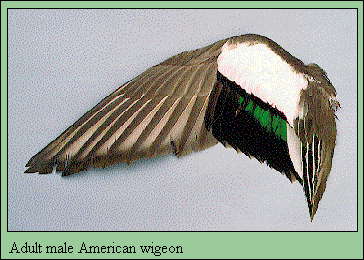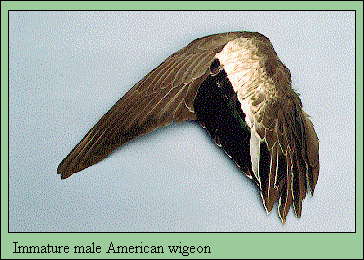






Adult females have a sharply defined white edging on both greater and middle tertial coverts. Usually the sharp white edging on the middle and lesser coverts is sufficient to identify adult females, however, a few are so lightly colored as to resemble immature males. A careful check of tertials and greater tertial coverts will serve to identify them.
Immature males usually have small, brownish tertials and tertial coverts, but by November these are often replaced with adult male-type feathers. The middle and lesser coverts are gray-brown and indistinctly edged with a lighter gray.
Immature females have small, brownish tertials and tertial coverts similar to those of immature males. By the middle of the fall hunting season these may be replaced with adult female-type feathers. The middle and lesser coverts are brownish with well-defined pale tan edges. Often the greater secondary coverts lack most of the black tipping common to wings of other ages and sexes and their outer webs are brownish gray to gray-white.
Separation of American wigeon wings from Eurasian wigeon wings can be accomplished using the following procedures:
American wigeon
Axillars (if present) entirely white or flecked only at their tips.
Underwing middle coverts all or nearly all white.
Scapulars of males (if present) are heavily vermiculated with reddish brown.
Eurasian wigeon
Axillars (if present) heavily flecked with gray over their entire length.
Underwing middle coverts heavily flecked with gray.
Scapulars of males (if present) are heavily vermiculated with black and white.
| Wing Character | Male | Female | ||
| Adult | Immature | Immature | Adult | |
| Scapulars | Vermiculated or barred or both | Barred | ||
| Underwing | Coverts gray, heavily flecked with white | Coverts brownish; heavily edged with white to gray | ||
| Occasionally as in females | ||||
| Middle and lesser coverts | Entirely white except few over tertials that are gray | Many white to gray-white; others brownish with light centers and poorly defined gray-white edging | Brownish with well defined light brown edges; a few have light centers | Brown; often with light center; each covert nearly circumscribed by a sharply defined white edging |
| Greater tertial coverts | Gray (including tips); somewhat pointed with narrow white edging | Brown with light gray-brown edging; often frayed and faded | Dark brown; edged with white to form a broadly rounded arc | |
| After molt: Similar to adult male | After molt: Similar to adult female | |||
| Tertials | Long; acutely pointed outer web shiny black with narrow white edge; inner web dull gray; rachis trimmed with white | Pointed; inner and outer webs brownish; edged with white; often frayed, faded or both at tips | Somewhat bluntly pointed; outer web brownish fray; rachis not trimmed with white | |
| After molt: Similar to adult male | After molt: Similar to adult female | |||
| Greater secondary coverts | 1/2 inch terminal black band; remainder of outer webs white; inner web gray | Terminal band reduced, poorly defined and/or restricted to proximal coverts; remainder of outer webs brownish gray to dull white; inner webs brownish gray | 1/2 inch terminal black band; remainder of outer webs white | |






